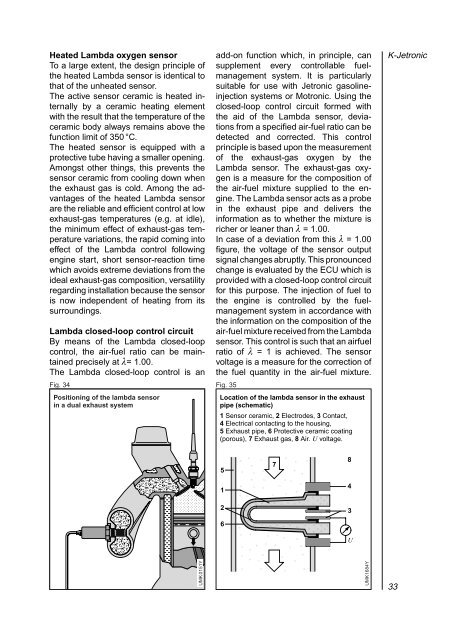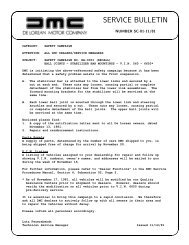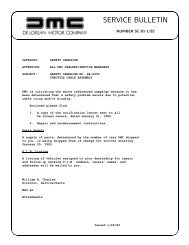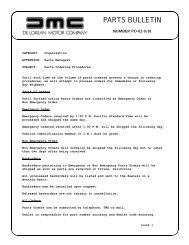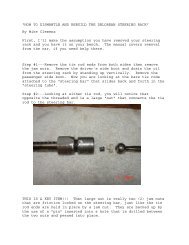Gasoline Fuel-Injection System K-Jetronic
Gasoline Fuel-Injection System K-Jetronic
Gasoline Fuel-Injection System K-Jetronic
You also want an ePaper? Increase the reach of your titles
YUMPU automatically turns print PDFs into web optimized ePapers that Google loves.
Heated Lambda oxygen sensor<br />
To a large extent, the design principle of<br />
the heated Lambda sensor is identical to<br />
that of the unheated sensor.<br />
The active sensor ceramic is heated internally<br />
by a ceramic heating element<br />
with the result that the temperature of the<br />
ceramic body always remains above the<br />
function limit of 350 °C.<br />
The heated sensor is equipped with a<br />
protective tube having a smaller opening.<br />
Amongst other things, this prevents the<br />
sensor ceramic from cooling down when<br />
the exhaust gas is cold. Among the advantages<br />
of the heated Lambda sensor<br />
are the reliable and efficient control at low<br />
exhaust-gas temperatures (e.g. at idle),<br />
the minimum effect of exhaust-gas temperature<br />
variations, the rapid coming into<br />
effect of the Lambda control following<br />
engine start, short sensor-reaction time<br />
which avoids extreme deviations from the<br />
ideal exhaust-gas composition, versatility<br />
regarding installation because the sensor<br />
is now independent of heating from its<br />
surroundings.<br />
Lambda closed-loop control circuit<br />
By means of the Lambda closed-loop<br />
control, the air-fuel ratio can be maintained<br />
precisely at λ= 1.00.<br />
The Lambda closed-loop control is an<br />
Fig. 34 Fig. 35<br />
Positioning of the lambda sensor<br />
in a dual exhaust system<br />
add-on function which, in principle, can<br />
supplement every controllable fuelmanagement<br />
system. It is particularly<br />
suitable for use with <strong>Jetronic</strong> gasolineinjection<br />
systems or Motronic. Using the<br />
closed-loop control circuit formed with<br />
the aid of the Lambda sensor, deviations<br />
from a specified air-fuel ratio can be<br />
detected and corrected. This control<br />
principle is based upon the measurement<br />
of the exhaust-gas oxygen by the<br />
Lambda sensor. The exhaust-gas oxygen<br />
is a measure for the composition of<br />
the air-fuel mixture supplied to the engine.<br />
The Lambda sensor acts as a probe<br />
in the exhaust pipe and delivers the<br />
information as to whether the mixture is<br />
richer or leaner than λ = 1.00.<br />
In case of a deviation from this λ = 1.00<br />
figure, the voltage of the sensor output<br />
signal changes abruptly. This pronounced<br />
change is evaluated by the ECU which is<br />
provided with a closed-loop control circuit<br />
for this purpose. The injection of fuel to<br />
the engine is controlled by the fuelmanagement<br />
system in accordance with<br />
the information on the composition of the<br />
air-fuel mixture received from the Lambda<br />
sensor. This control is such that an airfuel<br />
ratio of λ = 1 is achieved. The sensor<br />
voltage is a measure for the correction of<br />
the fuel quantity in the air-fuel mixture.<br />
Location of the lambda sensor in the exhaust<br />
pipe (schematic)<br />
1 Sensor ceramic, 2 Electrodes, 3 Contact,<br />
4 Electrical contacting to the housing,<br />
5 Exhaust pipe, 6 Protective ceramic coating<br />
(porous), 7 Exhaust gas, 8 Air. U voltage.<br />
K-<strong>Jetronic</strong><br />
,,,,,<br />
,,<br />
,,,,<br />
,,,,,<br />
,,<br />
,,,,<br />
,,,,<br />
,,,,<br />
,,,,<br />
,,,,<br />
,,,,<br />
,,,,,,<br />
,,,,,,<br />
,,,,,<br />
5<br />
1<br />
2<br />
6<br />
7<br />
8<br />
4<br />
3<br />
U<br />
UMK0151Y<br />
UMK1684Y<br />
33


